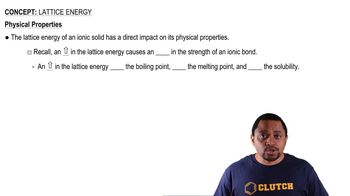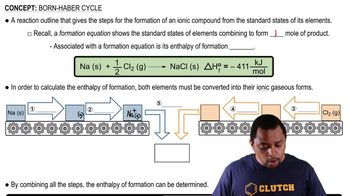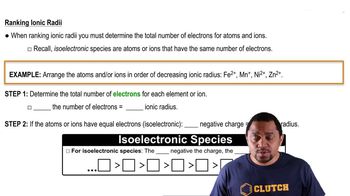Identify each statement as true or false: (b) Li+ is smaller than Li.
Ch.7 - Periodic Properties of the Elements
Chapter 7, Problem 29
Use data from Appendix C, Figure 7.10, and Figure 7.12 to calculate the lattice energy of RbCl.
 Verified step by step guidance
Verified step by step guidance1
Identify the Born-Haber cycle for RbCl, which involves the following steps: sublimation of Rb, ionization of Rb, dissociation of Cl2, electron affinity of Cl, and formation of RbCl from gaseous ions.
Write the equation for the formation of RbCl from its elements in their standard states: \( \text{Rb(s)} + \frac{1}{2} \text{Cl}_2(g) \rightarrow \text{RbCl(s)} \).
Use the enthalpy of sublimation for Rb to convert solid Rb to gaseous Rb: \( \text{Rb(s)} \rightarrow \text{Rb(g)} \).
Use the ionization energy of Rb to convert gaseous Rb to \( \text{Rb}^+ \): \( \text{Rb(g)} \rightarrow \text{Rb}^+(g) + e^- \).
Use the electron affinity of Cl to convert gaseous Cl to \( \text{Cl}^- \): \( \text{Cl}(g) + e^- \rightarrow \text{Cl}^-(g) \).

Verified video answer for a similar problem:
This video solution was recommended by our tutors as helpful for the problem above.
Video duration:
3mWas this helpful?
Key Concepts
Here are the essential concepts you must grasp in order to answer the question correctly.
Lattice Energy
Lattice energy is the amount of energy released when gaseous ions combine to form an ionic solid. It is a measure of the strength of the forces between the ions in an ionic compound. Higher lattice energy indicates stronger ionic bonds, which typically results in higher melting and boiling points for the compound.
Recommended video:
Guided course

Lattice Energy
Born-Haber Cycle
The Born-Haber cycle is a thermodynamic cycle that relates the lattice energy of an ionic compound to other energy changes involved in its formation. It includes steps such as ionization energy, electron affinity, and sublimation energy, allowing for the calculation of lattice energy using Hess's law. This cycle is essential for understanding how lattice energy can be derived from other measurable quantities.
Recommended video:
Guided course

Born Haber Cycle
Ionic Radii
Ionic radii refer to the effective size of an ion in a crystal lattice. The size of the ions affects the distance between them, which in turn influences the lattice energy. Smaller ions can pack more closely together, leading to stronger electrostatic attractions and higher lattice energies, while larger ions result in weaker attractions and lower lattice energies.
Recommended video:
Guided course

Ranking Ionic Radii
Related Practice
Textbook Question
Textbook Question
Identify each statement as true or false: (c) Cl- is bigger than I-.
Textbook Question
Which neutral atom is isoelectronic with each of the following ions? Ga3+, Zr4+, Mn7+, I−, Pb2+.
4
views
Textbook Question
Some ions do not have a corresponding neutral atom that has the same electron configuration. For each of the following ions, identify the neutral atom that has the same number of electrons and determine if this atom has the same electron configuration. (a) CI−, (b) Sc3+, (c) Fe2+, (d) Zn2+, (e) Sn4+.
1
views
Textbook Question
Consider the isoelectronic ions F- and Na+. (b) Using Equation 7.1 and assuming that core electrons contribute 1.00 and valence electrons contribute 0.00 to the screening constant, S, calculate Zeff for the 2p electrons in both ions.
